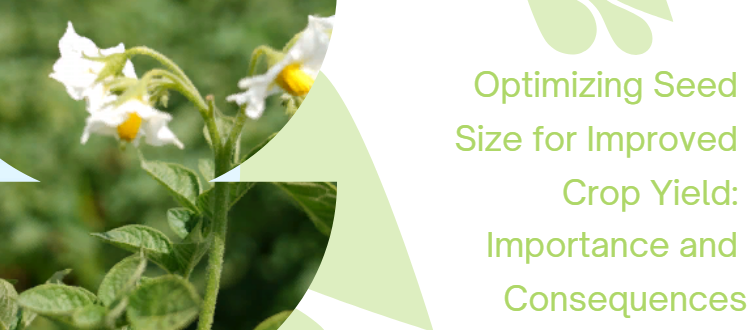#SeedSizeOptimization #UniformSeedTubers #CropYieldEnhancement #PlanterEfficiency #PotatoVirusY #SeedCuttingEquipmentCalibration
Assessing and selecting the appropriate size and uniformity of seed tubers is crucial for optimizing crop yield. This article explores the impact of seed tuber size on the performance of cut-seed pieces, discussing the benefits of using smaller, uniformly sized mother tubers. It highlights the advantages of uniform seed size, such as producing blocky cut-seed pieces, increasing the proportion of productive seed piece sizes, and enhancing planter efficiency. Conversely, planting excessively small or large seed pieces can result in weak plants, planting skips, excessive stems, and inconsistent feeding through the planter, leading to reduced yield. Furthermore, research has shown a connection between planter skips and the incidence of potato virus Y in crops. Additionally, the article emphasizes the importance of checking and calibrating seed cutting equipment for optimal performance.
The size and uniformity of seed tubers play a significant role in determining the success of potato cultivation. When purchasing seed tubers, it is crucial to assess their size and ensure uniformity to maximize crop yield. The performance of cut-seed pieces is directly affected by the size of the uncut mother tubers. Smaller, uniformly sized mother tubers offer several advantages.
Firstly, they result in uniform, blocky cut-seed pieces. These uniform pieces are easier to handle during planting and contribute to consistent plant spacing. The blocky shape promotes efficient use of planting machinery, reducing the risk of planting skips or doubles.
Secondly, smaller and uniform mother tubers yield a higher proportion of the most productive seed piece sizes, typically ranging from 43 to 85 grams. These seed pieces are ideal for robust plant development and optimal yield potential. By focusing on these preferred sizes, farmers can enhance the quality of their crop and increase their chances of a successful harvest.
Furthermore, planting excessively small seed pieces, often referred to as “slivers,” can lead to weak and unproductive plants. These small pieces lack an adequate supply of carbohydrates necessary for vigorous growth and development. As a result, the plants may struggle to establish themselves and fail to reach their full potential.
On the other hand, planting large seed pieces exceeding 85 grams can lead to potential issues. These oversized pieces may fall off the planter cups during planting, resulting in skips or uneven plant distribution. Additionally, plants grown from large seed pieces tend to produce excessive stems, diverting energy away from tuber formation. This can negatively impact the overall yield and quality of the crop.
Wide variations in seed piece sizes can also cause skips and doubles during planting. Inconsistent feeding through the planter can disrupt the planting process, resulting in uneven spacing and compromised crop uniformity. Notably, research conducted in the United States has identified a connection between planter skips and the incidence of potato virus Y (PVY) in crops. A gap in plant stands, equivalent to the loss of three or more consecutive plants within a row, has been found to favor the spread of PVY.
Moreover, it is essential to recognize that seed pieces cut from larger mother tubers (greater than 225 grams) are not as productive as pieces of the same weight cut from smaller tubers. Larger tubers tend to have fewer eyes, resulting in blind seed pieces with no eyes. Planting blind seed pieces can lead to a reduced plant stand and lower overall yield.
To optimize the cutting process, it is advisable to check and calibrate the seed cutting equipment. This ensures that the equipment is optimized for the specific seed lot. One effective method involves sorting a 5 kg sample of cut seed into size categories: too small (less than 42 grams), preferred size (42 to 85 grams), and too large (more than 85 grams). By analyzing the distribution of seed sizes, adjustments can be made to the cutting operation as required, ensuring consistent and accurate cutting.
Investing time and effort into assessing and selecting seed tubers of appropriate size and uniformity can have significant consequences for crop development and overall yield. By opting for smaller, uniformly sized mother tubers, farmers can expect more blocky cut-seed pieces, a higher proportion of productive seed piece sizes, improved planter efficiency, and better crop uniformity. On the other hand, neglecting to consider seed tuber size and uniformity can result in weak plants, planting skips, excessive stems, inconsistent feeding through the planter, and reduced crop yield.
Source: Australian Potato Growers







